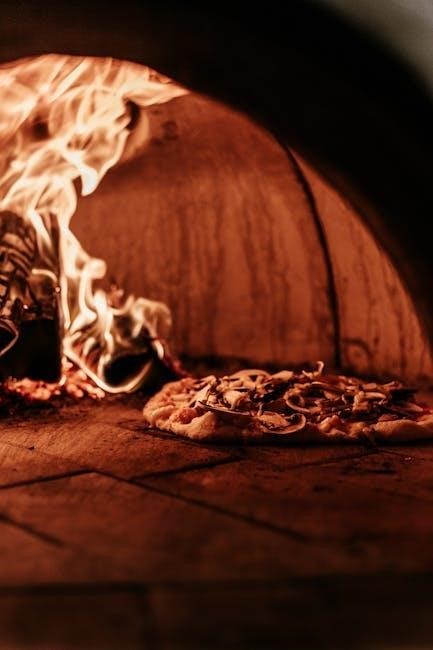
How to Cook Pizza Rolls in the Oven: A Comprehensive Guide
Cooking pizza rolls in the oven is a quick and delicious way to achieve crispy, golden treats․ Preheat your oven to 425°F, arrange the rolls on a parchment-lined baking sheet, and bake for 8-10 minutes․ This method ensures a perfectly cooked exterior and a gooey, cheesy interior․ Perfect for snacks or appetizers!
Pizza rolls are a delightful and convenient snack filled with cheese, savory sauce, and various pizza toppings, all wrapped in a crispy dough․ These bite-sized treats are perfect for quick meals, parties, or satisfying cravings․ They offer the classic flavors of pizza in an easy-to-eat format․ Whether homemade or store-bought, pizza rolls are a crowd favorite due to their versatility and delicious taste․ Oven baking is a popular method to achieve the perfect balance of a golden, crispy exterior and a warm, cheesy interior, making them a satisfying option for any occasion․
Benefits of Baking Pizza Rolls in the Oven
Baking pizza rolls in the oven offers numerous advantages․ It ensures a crispy exterior and a warm, cheesy interior, enhancing the overall texture and flavor․ Unlike microwaving, oven baking provides even cooking and prevents sogginess․ This method is also healthier than deep-frying, as it requires minimal oil․ Additionally, baking allows you to cook multiple rolls at once, making it ideal for large groups․ The controlled heat of the oven guarantees consistent results, delivering a delicious snack that satisfies cravings without extra effort․ It’s a convenient and flavorful way to enjoy pizza rolls perfectly every time․
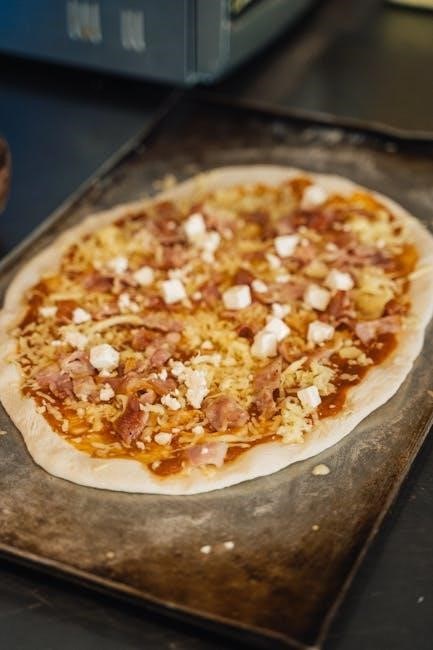
Essential Supplies for Baking Pizza Rolls
Oven Requirements
A preheated oven at 400°F to 425°F is essential for baking pizza rolls․ Ensure the oven reaches the correct temperature before placing the rolls inside for even cooking․
To achieve perfectly cooked pizza rolls, a preheated oven is crucial․ Set your oven to 400°F to 425°F, depending on the desired crispiness․ Preheating ensures even cooking and prevents undercooked or burnt rolls․ Use the middle rack for uniform heat distribution and avoid overcrowding the baking sheet․ For accuracy, consider using an oven thermometer․ Proper oven preparation is key to achieving crispy exteriors and gooey interiors․ Always preheat the oven for at least 10 minutes before baking for optimal results․
Baking Sheets and Parchment Paper
For optimal results, use a sturdy baking sheet lined with parchment paper to prevent sticking and ensure easy cleanup․ Lightly brush the parchment with butter or oil for extra crispiness․ Arrange pizza rolls in a single layer, leaving about 1 inch of space between each roll to allow even cooking․ Optionally, sprinkle cornmeal on the parchment for added crispiness․ For a neat arrangement, place the rolls in rows, ensuring they are evenly spread․ Using a larger baking sheet or multiple sheets helps avoid overcrowding, promoting even browning and preventing rolls from sticking together․
Optional Toppings and Seasonings
Enhance your pizza rolls with optional toppings like extra cheese, pepperoni slices, or diced herbs for added flavor․ Sprinkle garlic powder or Italian seasoning before baking for a savory twist․ For a cheesy burst, sprinkle shredded mozzarella or parmesan on top․ You can also brush the rolls with garlic butter or olive oil for a golden finish․ Experiment with spices like paprika or oregano for a personalized touch․ These additions elevate the flavor and texture, making your pizza rolls truly unforgettable!

Preheating the Oven
Preheat your oven to 425°F (220°C) for optimal results․ Allow the oven to fully preheat for 10-15 minutes to ensure even cooking and a crispy exterior for your pizza rolls․
Recommended Oven Temperature
The ideal oven temperature for cooking pizza rolls is between 400°F and 425°F (200°C to 220°C)․ A higher temperature ensures a crispy exterior without overcooking the interior․ Preheat the oven to 425°F for optimal results, as this temperature balances browning and cooking time․ Lower temperatures may result in a softer texture, while higher temperatures can cause burning․ Always preheat the oven for 10-15 minutes before baking to ensure consistent heat distribution․
Preheating Time and Preparation
Preheating the oven is crucial for even cooking․ Allow the oven to preheat for 10-15 minutes at 425°F before baking pizza rolls․ Place the rolls on a parchment-lined baking sheet during preheating if using the cold oven method․ This ensures the rolls cook evenly as the oven heats up․ For a crispy texture, avoid overcrowding the baking sheet and ensure rolls are spaced evenly․ Proper preparation and preheating are key to achieving golden, perfectly cooked pizza rolls every time․
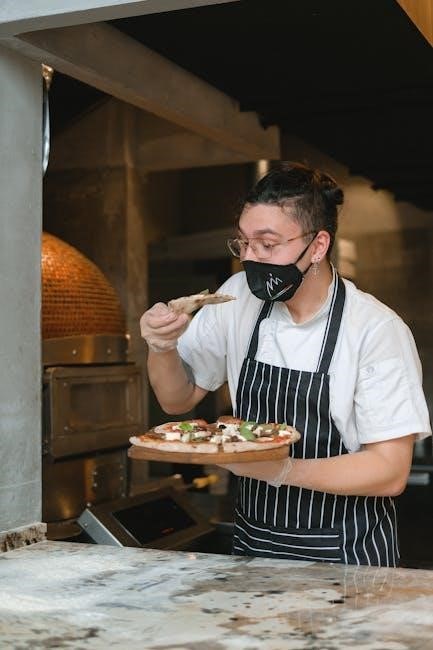
Preparing the Baking Sheet
Line the baking sheet with parchment paper to prevent sticking and ensure easy cleanup․ Arrange pizza rolls in a single layer, leaving space for even air circulation and cooking․ Lightly brush with oil or butter for crispiness if desired․ This setup ensures golden, perfectly cooked rolls every time․ Always prepare the sheet before placing the rolls to avoid sticking and make serving easier․ Proper preparation guarantees a crispy texture and hassle-free cleanup․ Keep the sheet ready before placing the rolls for baking․ Ensure the sheet is clean and dry for optimal results․ Maintain a clean surface to prevent any residue from affecting the rolls․ Properly preparing the baking sheet is essential for achieving the best results․ Always use parchment paper to avoid sticking and make cleanup easy․ Arrange the rolls neatly and evenly to ensure consistent cooking․ Lightly brushing with oil enhances crispiness and flavor․ This simple step ensures your pizza rolls bake perfectly every time․ Keeping the sheet well-prepared is key to a successful baking experience․ Always line the baking sheet with parchment paper for easy cleanup․ Arrange pizza rolls in a single layer, leaving space for air circulation․ Lightly brush with oil or butter for crispiness․ Proper preparation ensures golden, perfectly cooked rolls․ Line the baking sheet with parchment paper to prevent sticking․ Arrange pizza rolls in a single layer, leaving space for even air circulation․ Lightly brush with oil or butter for crispiness․ This ensures golden, perfectly cooked rolls every time․ Always prepare the baking sheet before placing the rolls to avoid sticking․ Ensure the sheet is clean and dry for optimal results․ Maintain a clean surface to prevent residue from affecting the rolls․ Properly preparing the baking sheet is essential for achieving the best results․ Always use parchment paper to avoid sticking and make cleanup easy․ Arrange the rolls neatly and evenly for consistent cooking․ Lightly brushing with oil enhances crispiness and flavor․ This simple step ensures your pizza rolls bake perfectly every time․ Keeping the sheet well-prepared is key to a successful baking experience․ Line the baking sheet with parchment paper to prevent sticking․ Arrange pizza rolls in a single layer, leaving space for air circulation․ Lightly brush with oil or butter for crispiness․ Proper preparation ensures golden, perfectly cooked rolls․ Always prepare the baking sheet before placing the rolls to avoid sticking․ Ensure the sheet is clean and dry for optimal results․ Maintain a clean surface to prevent residue from affecting the rolls․ Properly preparing the baking sheet is essential for achieving the best results․ Always use parchment paper to avoid sticking and make cleanup easy․ Arrange the rolls neatly and evenly for consistent cooking․ Lightly brushing with oil enhances crispiness and flavor․ This simple step ensures your pizza rolls bake perfectly every time․ Keeping the sheet well-prepared is key to a successful baking experience․ Line the baking sheet with parchment paper to prevent sticking․ Arrange pizza rolls in a single layer, leaving space for air circulation․ Lightly brush with oil or butter for crispiness․ Proper preparation ensures golden, perfectly cooked rolls․ Always prepare the baking sheet before placing the rolls to avoid sticking․ Ensure the sheet is clean and dry for optimal results․ Maintain a clean surface to prevent residue from affecting the rolls․ Properly preparing the baking sheet is essential for achieving the best results․ Always use parchment paper to avoid sticking and make cleanup easy․ Arrange the rolls neatly and evenly for consistent cooking․ Lightly brushing with oil enhances crispiness and flavor․ This simple step ensures your pizza rolls bake perfectly every time․ Keeping the sheet well-prepared is key to a successful baking experience․ Line the baking sheet with parchment paper to prevent sticking․ Arrange pizza rolls in a single layer, leaving space for air circulation․ Lightly brush with oil or butter for crispiness․ Proper preparation ensures golden, perfectly cooked rolls․ Always prepare the baking sheet before placing the rolls to avoid sticking․ Ensure the sheet is clean and dry for optimal results․ Maintain a clean surface to prevent residue from affecting the rolls․ Properly preparing the baking sheet is essential for achieving the best results․ Always use parchment paper to avoid sticking and make cleanup easy․ Arrange the rolls neatly and evenly for consistent cooking․ Lightly brushing with oil enhances crispiness and flavor․ This simple step ensures your pizza rolls bake perfectly every time․ Keeping the sheet well-prepared is key to a successful baking experience․ Line the baking sheet with parchment paper to prevent sticking․ Arrange pizza rolls in a single layer, leaving space for air circulation․ Lightly brush with oil or butter for crispiness․ Proper preparation ensures golden, perfectly cooked rolls․ Always prepare the baking sheet before placing the rolls to avoid sticking․ Ensure the sheet is clean and dry for optimal results․ Maintain a clean surface to prevent residue from affecting the rolls․ Properly preparing the baking sheet is essential for achieving the best results․ Always use parchment paper to avoid sticking and make cleanup easy․ Arrange the rolls neatly and evenly for consistent cooking․ Lightly brushing with oil enhances crispiness and flavor․ This simple step ensures your pizza rolls bake perfectly every time․ Keeping the sheet well-prepared is key to a successful baking experience․ Line the baking sheet with parchment paper to prevent sticking․ Arrange pizza rolls in a single layer, leaving space for air circulation․ Lightly brush with oil or butter for crispiness․ Proper preparation ensures golden, perfectly cooked rolls․ Always prepare the baking sheet before placing the rolls to avoid sticking․ Ensure the sheet is clean and dry for optimal results․ Maintain a clean surface to prevent residue from affecting the rolls․ Properly preparing the baking sheet is essential for achieving the best results․ Always use parchment paper to avoid sticking and make cleanup easy․ Arrange the rolls neatly and evenly for consistent cooking․ Lightly brushing with oil enhances crispiness and flavor․ This simple step ensures your pizza rolls bake perfectly every time․ Keeping the sheet well-prepared is key to a successful baking experience․ Line the baking sheet with parchment paper to prevent sticking․ Arrange pizza rolls in a single layer, leaving space for air circulation․ Lightly brush with oil or butter for crispiness․ Proper preparation ensures golden, perfectly cooked rolls․ Always prepare the baking sheet before placing the rolls to avoid sticking․ Ensure the sheet is clean and dry for optimal results․ Maintain a clean surface to prevent residue from affecting the rolls․ Properly preparing the baking sheet is essential for achieving the best results․ Always use parchment paper to avoid sticking and make cleanup easy․ Arrange the rolls neatly and evenly for consistent cooking․ Lightly brushing with oil enhances crispiness and flavor․ This simple step ensures your pizza rolls bake perfectly every time․ Keeping the sheet well-prepared is key to a successful baking experience․ Line the baking sheet with parchment paper to prevent sticking․ Arrange pizza rolls in a single layer, leaving space for air circulation․ Lightly brush with oil or butter for crispiness․ Proper preparation ensures golden, perfectly cooked rolls․ Always prepare the baking sheet before placing the rolls to avoid sticking․ Ensure the sheet is clean and dry for optimal results․ Maintain a clean surface to prevent residue from affecting the rolls․ Properly preparing the baking sheet is essential for achieving the best results․ Always use parchment paper to avoid sticking and make cleanup easy․ Arrange the rolls neatly and evenly for consistent cooking․ Lightly brushing with oil enhances crispiness and flavor․ This simple step ensures your pizza rolls bake perfectly every time․ Keeping the sheet well-prepared is key to a successful baking experience․ Line the baking sheet with parchment paper to prevent sticking․ Arrange pizza rolls in a single layer, leaving space for air circulation․ Lightly brush with oil or butter for crispiness․ Proper preparation ensures golden, perfectly cooked rolls․ Always prepare the baking sheet before placing the rolls to avoid sticking․ Ensure the sheet is clean and dry for optimal results․ Maintain a clean surface to prevent residue from affecting the rolls․ Properly preparing the baking sheet is essential for achieving the best results․ Always use parchment paper to avoid sticking and make cleanup easy․ Arrange the rolls neatly and evenly for consistent cooking․ Lightly brushing with oil enhances crispiness and flavor․ This simple step ensures your pizza rolls bake perfectly every time․ Keeping the sheet well-prepared is key to a successful baking experience․ Line the baking sheet with parchment paper to prevent sticking․ Arrange pizza rolls in a single layer, leaving space for air circulation․ Lightly brush with oil or butter for crispiness; Proper preparation ensures golden, perfectly cooked rolls․ Always prepare the baking sheet before placing the rolls to avoid sticking․ Ensure the sheet is clean and dry for optimal results․ Maintain a clean surface to prevent residue from affecting the rolls․ Properly preparing the baking sheet is essential for achieving the best results․ Always use parchment paper to avoid sticking and make cleanup easy․ Arrange the rolls neatly and evenly for consistent cooking․ Lightly brushing with oil enhances crispiness and flavor․ This simple step ensures your pizza rolls bake perfectly every time․ Keeping the sheet well-prepared is key to a successful baking experience․ Line the baking sheet with parchment paper to prevent sticking․ Arrange pizza rolls in a single layer, leaving space for air circulation․ Lightly brush with oil or butter for crispiness․ Proper preparation ensures golden, perfectly cooked rolls․ Always prepare the baking sheet before placing the rolls to avoid sticking․ Ensure the sheet is clean and dry for optimal results․ Maintain a clean surface to prevent residue from affecting the rolls․ Properly preparing the baking sheet is essential for achieving the best results․ Always use parchment paper to avoid sticking and make cleanup easy․ Arrange the rolls neatly and evenly for consistent cooking․ Lightly brushing with oil enhances crispiness and flavor․ This simple step ensures your pizza rolls bake perfectly every time․ Keeping the sheet well-prepared is key to a successful baking experience․ Line the baking sheet with parchment paper to prevent sticking․ Arrange pizza rolls in a single layer, leaving space for air circulation․ Lightly brush with oil or butter for crispiness․ Proper preparation ensures golden, perfectly cooked rolls․ Always prepare the baking sheet before placing the rolls to avoid sticking․ Ensure the sheet is clean and dry for optimal results․ Maintain a clean surface to prevent residue from affecting the rolls․ Properly preparing the baking sheet is essential for achieving the best results․ Always use
Arranging Pizza Rolls
Place pizza rolls on a parchment-lined baking sheet in a single layer, leaving about 1 inch of space between each roll to prevent sticking․ Position them seam-side down to maintain shape and ensure even cooking․ Avoid overcrowding, as this can lead to uneven baking․ If necessary, cook in batches to accommodate all rolls․ Place the baking sheet on the middle rack of the oven for balanced heat distribution․ Proper arrangement ensures crispy, evenly cooked pizza rolls with a golden finish․
Spacing and Positioning
Ensure pizza rolls are spaced about 1 inch apart on the baking sheet to allow even air circulation and prevent sticking․ Position them seam-side down to prevent unraveling and promote even cooking․ Avoid overcrowding, as this can lead to uneven browning and undercooked areas․ If necessary, use multiple baking sheets or cook in batches․ Proper spacing and positioning are crucial for achieving crispy, perfectly cooked pizza rolls with a golden exterior and a soft, cheesy interior․
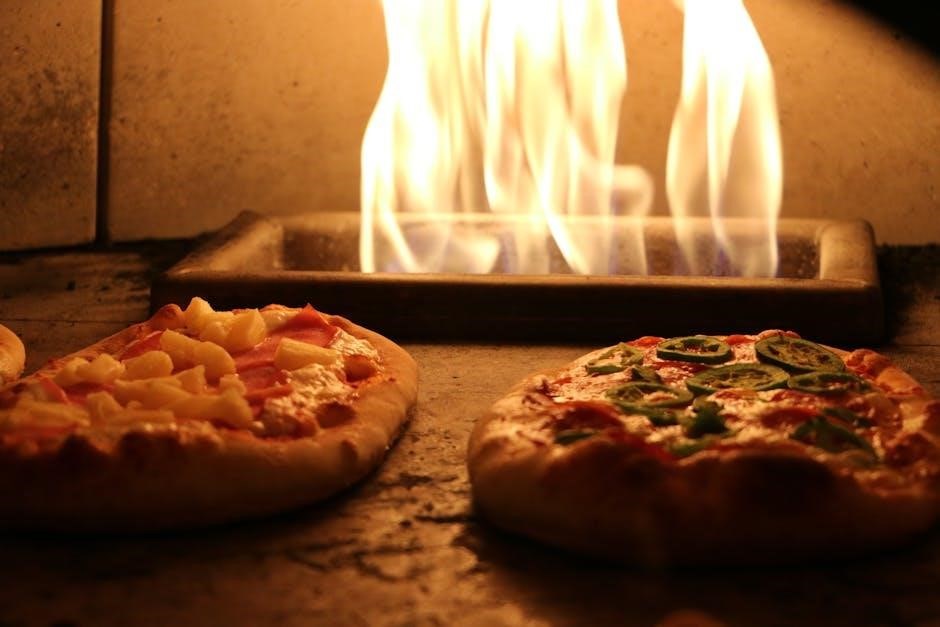
Baking Instructions
Preheat the oven to 425°F․ Place pizza rolls on a parchment-lined baking sheet, leaving space for even cooking․ Bake for 8-10 minutes until golden brown and crispy․
Cooking Time and Temperature
For perfectly baked pizza rolls, preheat your oven to 425°F (220°C)․ Place the rolls on a parchment-lined baking sheet, leaving about 1 inch of space between each․ Bake for 8-10 minutes, or until golden brown and crispy․ If you prefer a softer texture, bake at 400°F (200°C) for 10-12 minutes․ Keep an eye on them during the last few minutes to avoid burning․ The ideal temperature ensures a crispy exterior while maintaining a gooey, cheesy interior․ Adjust time slightly for softer or crisper results․
Monitoring the Pizza Rolls
Monitoring your pizza rolls while they bake is essential to achieve the perfect texture․ Check them after 6-7 minutes, as ovens can vary in heat distribution․ Look for a golden-brown color and crispy edges; If they appear pale, continue baking in 1-minute increments until golden․ Avoid overcooking, as this can lead to dryness․ Use a timer and keep an eye on them during the final minutes to ensure they don’t burn․ Proper monitoring ensures a crispy exterior and a cheesy, flavorful interior every time․
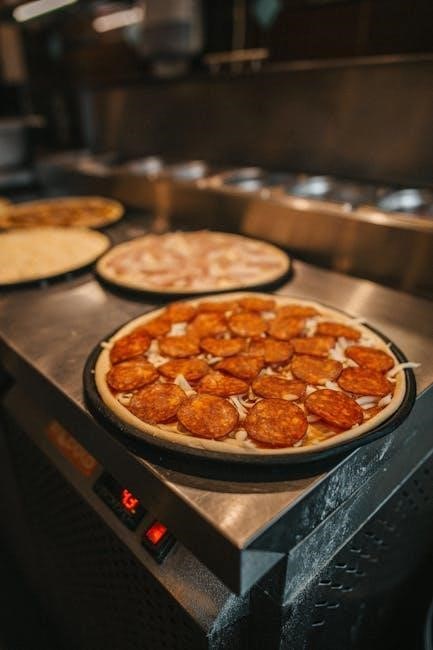
Additional Tips for Perfect Pizza Rolls
For perfect pizza rolls, brush with butter or oil before baking for crispiness․ Sprinkle with garlic butter for extra flavor․ Arrange neatly to prevent unraveling․
Optional Butter or Oil Brushing
Brushing pizza rolls with butter or oil before baking enhances crispiness and flavor․ Melted butter adds a golden, savory touch, while oil provides a lighter option․ For extra flavor, mix garlic or herbs into the butter․ Gently brush the tops and sides of the rolls before baking․ This step ensures a delicious, aromatic crust․ Experiment with different seasonings like garlic powder or Italian herbs for unique twists․ This simple addition elevates the rolls to a new level of tastiness, making them irresistible to snackers of all ages․
Preventing Rolls from Unraveling
To prevent pizza rolls from unraveling, ensure they are tightly sealed before baking․ Place them seam-side down on the baking sheet to minimize opening during cooking․ For extra security, tuck the rolls close together in a single layer or use a 9×13 inch baking pan․ This helps them hold their shape and prevents filling from escaping․ Lightly pressing the seams with a fork can also seal them more effectively․ Proper arrangement ensures intact, evenly cooked rolls with all the delicious filling inside․
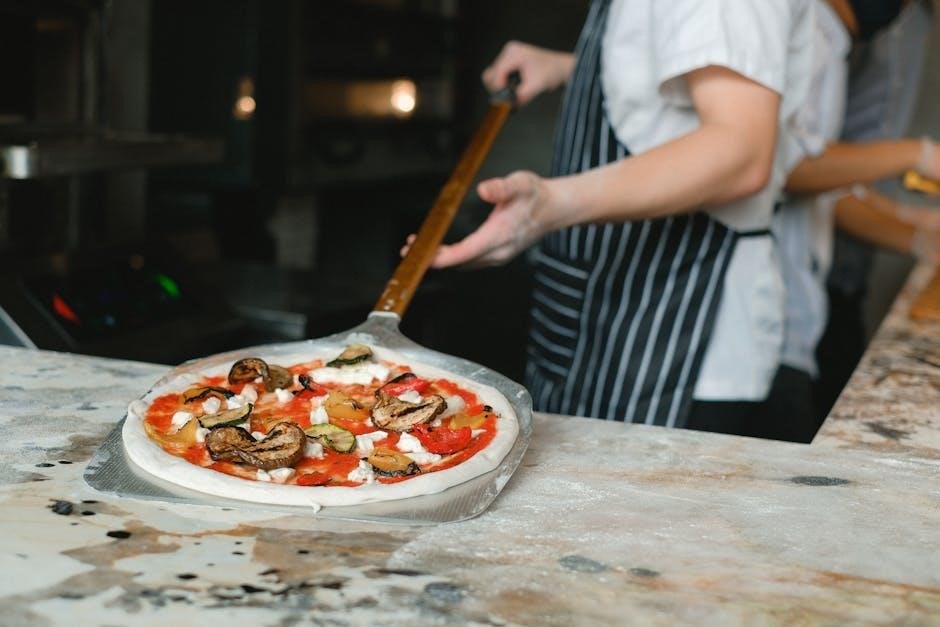
Cooking Variations
Explore different cooking methods and temperatures to customize your pizza rolls․ Try baking at 400°F for a softer texture or 425°F for crispiness․ Experiment with a toaster oven or air fryer for alternative results, achieving golden, cheesy perfection every time․
Different Oven Temperatures
Oven temperature plays a crucial role in achieving the perfect texture for pizza rolls․ Baking at 400°F ensures a softer exterior, while 425°F yields a crispier crust․ For larger batches, a lower temperature like 375°F can prevent burning, though it may extend cooking time․ Experimenting with different temperatures allows you to customize the texture to your liking․ Keep an eye on the rolls after 8-10 minutes, as oven variations can affect cooking time․ Adjusting the temperature can help achieve your desired level of crispiness or softness․
Toaster Oven vs․ Conventional Oven
Cooking pizza rolls in a toaster oven versus a conventional oven offers distinct results․ Toaster ovens cook faster, achieving crispiness in 6-8 minutes at 425°F, while conventional ovens may take 8-10 minutes for the same temperature․ Toaster ovens provide even browning due to their compact size, while conventional ovens are better for large batches․ Both methods yield delicious results, so choose based on your preference and available tools for the perfect pizza roll texture․
Customizing Your Pizza Rolls
Elevate your pizza rolls by adding personal touches․ Sprinkle with herbs, spices, or cheese before baking for extra flavor․ Try garlic butter or custom toppings for a unique twist!
Adding Toppings Before Baking
Add extra flavor to your pizza rolls by incorporating toppings before baking․ Sprinkle shredded mozzarella, parmesan, or your favorite herbs like oregano or basil․ For a spicy kick, add red pepper flakes or sliced jalapeños․ You can also drizzle with olive oil or garlic butter for enhanced taste․ Toppings should be added sparingly to avoid overpowering the rolls․ This step allows you to customize each batch according to your preferences, making every bite uniquely delicious․ Experiment with different combinations for a personalized touch!
Garlic Butter and Seasoning Options
Enhance the flavor of your pizza rolls by brushing them with garlic butter before baking․ Mix softened butter with minced garlic and a pinch of salt for a rich, aromatic taste․ Additionally, sprinkle seasonings like oregano, basil, or red pepper flakes for extra flavor․ For a spicy kick, try adding a dash of cayenne pepper or smoked paprika․ These simple additions elevate your pizza rolls to a delicious new level, offering a customizable and mouthwatering experience․
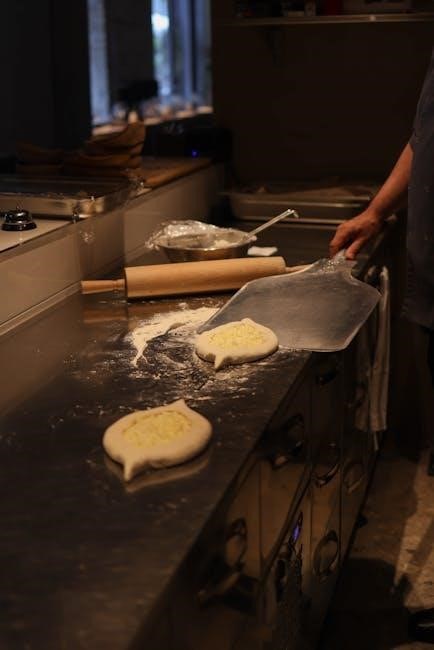
Post-Baking Steps
After baking, let the pizza rolls cool for a few minutes on the baking sheet․ Serve warm with optional dipping sauces like marinara or ranch for added flavor․
Cooling and Serving
Once baked, remove the pizza rolls from the oven and let them cool on the baking sheet for 2-3 minutes․ This prevents burning when handling․ Serve warm, optionally with marinara sauce, ranch dressing, or your favorite dip․ For leftovers, store them in an airtight container and reheat in the oven at 350°F for 3-5 minutes․ Cooling slightly ensures the rolls retain their shape and flavor, while serving warm enhances the crispy texture and gooey cheese experience․
Optional Dipping Sauces
Enhance your pizza rolls with a variety of dipping sauces for added flavor․ Marinara sauce is a classic choice, offering a tangy, savory complement to the cheesy filling․ Ranch dressing provides a creamy twist, while garlic butter or blue cheese sauce adds a rich, indulgent touch․ For a spicy kick, try dipping in buffalo sauce or salsa; Experiment with combinations to find your perfect match․ These sauces elevate the pizza roll experience, making it even more enjoyable as a snack or appetizer․
Safety and Best Practices
Always preheat the oven safely and use oven mitts to handle hot baking sheets․ Ensure proper ventilation and avoid overcrowding to prevent accidents․ Keep the oven clean to maintain safety and efficiency while cooking pizza rolls․ These practices ensure a secure and enjoyable cooking experience․
Oven Safety Tips
When cooking pizza rolls, always preheat your oven with caution․ Use oven mitts to handle hot baking sheets to prevent burns․ Avoid overcrowding the oven to ensure proper air circulation and even cooking․ Never leave the oven unattended while baking, as this can lead to accidents․ Keep children away from the oven while it’s in use․ Regularly clean your oven to prevent food residue from catching fire․ These simple precautions ensure a safe and enjoyable cooking experience․ Always follow the manufacturer’s guidelines for your specific oven model to maintain safety standards․
Avoiding Overcrowding the Baking Sheet
To ensure even cooking and prevent pizza rolls from sticking together, avoid overcrowding the baking sheet․ Arrange the rolls in a single layer with at least 1 inch of space between each roll․ Overcrowding can lead to uneven cooking, resulting in rolls that are undercooked or soggy․ If necessary, use multiple baking sheets or cook in batches․ This ensures proper air circulation and helps achieve a crispy exterior․ Always place rolls on a parchment-lined sheet for easy cleanup and to prevent sticking․
Troubleshooting Common Issues
Common issues when baking pizza rolls include uneven cooking, burning, or undercooked centers․ Adjusting oven temperature, ensuring proper spacing, and monitoring cooking time can resolve these problems effectively․
Preventing Burning
To prevent pizza rolls from burning, ensure they are spaced evenly on the baking sheet, allowing air to circulate․ Keep an eye on them during the last few minutes of baking, as oven temperatures can vary․ Using parchment paper and avoiding overcrowding helps maintain even cooking․ If you notice browning too quickly, cover the top with foil to finish cooking without burning․ This ensures a perfectly golden crust every time․
Ensuring Even Cooking
For even cooking, preheat the oven to the recommended temperature and place pizza rolls in a single layer on a parchment-lined baking sheet․ Avoid overcrowding, as this can prevent air from circulating evenly; Rotate the baking sheet halfway through cooking to ensure uniform browning․ Keep an eye on the rolls during the final minutes, as oven temperatures may vary slightly․ This method guarantees all rolls are crispy and golden without undercooking or burning․
Cooking pizza rolls in the oven yields a delightful snack with a crispy exterior and cheesy interior, ensuring satisfaction every time․ Enjoy your perfectly cooked treats!
Final Tips for Achieving Crispy Pizza Rolls
To achieve perfectly crispy pizza rolls, ensure your oven is preheated to the correct temperature, typically around 425°F; Arrange the rolls in a single layer on a parchment-lined baking sheet, leaving space between them for even cooking․ Bake for 8-10 minutes, or until golden brown․ For extra crispiness, lightly brush the tops with olive oil or butter before baking․ Avoid overcrowding, as this can lead to uneven cooking and a softer texture․ By following these tips, you’ll enjoy crunchy, flavorful pizza rolls every time!
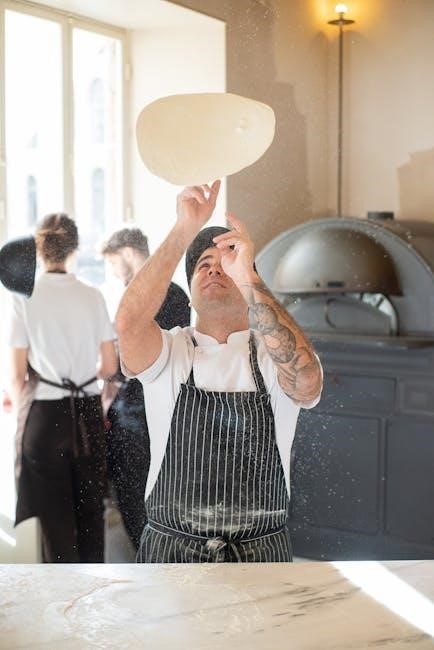
Bonus: Advanced Techniques
For a gourmet twist, try air-frying pizza rolls for extra crispiness or deep-frying for a crunchy exterior․ Experiment with garlic butter seasoning or herbs for enhanced flavor․
Air Fryer vs․ Oven Cooking
Air fryers and ovens offer distinct results for pizza rolls․ Air fryers produce a crisper exterior with less oil, cooking in 5-7 minutes at 400°F․ Ovens provide even cooking for larger batches, achieving a golden exterior in 10-12 minutes at 425°F․ Both methods yield delicious results, but air fryers are faster and healthier, while ovens are better for quantity․ Choose based on your preference for crispiness, convenience, or cooking capacity․ Experiment with both to find your perfect pizza roll texture and flavor․
Deep-Frying Pizza Rolls
Deep-frying pizza rolls offers an extra crispy exterior and a indulgent treat․ Heat oil to 350°F in a deep pot or fryer․ Carefully place rolls in batches, avoiding overcrowding․ Cook for 2-3 minutes on each side until golden brown․ Remove with a slotted spoon and drain on paper towels․ For an extra flavor boost, toss rolls in garlic butter or seasonings post-frying․ This method yields a crunchy texture and savory taste, perfect for those who enjoy a fried twist on oven-baked rolls․ Ensure oil temperature is maintained for even cooking․
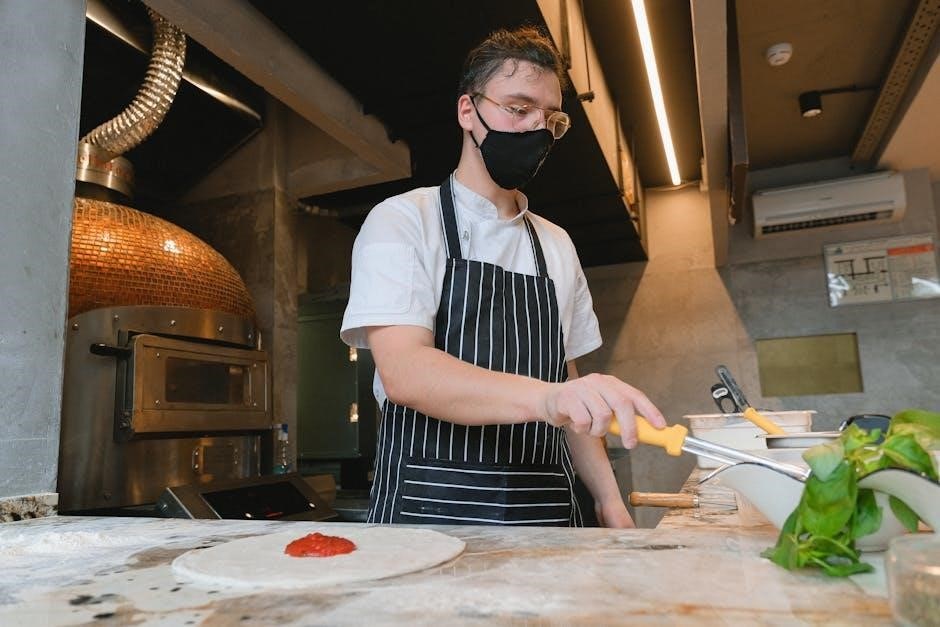
Final Thoughts
Storing Leftover Pizza Rolls
Store leftover pizza rolls in an airtight container in the refrigerator for up to 3 days or freeze for up to 2 months․ Reheat in the oven or microwave for a quick snack․